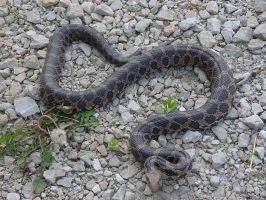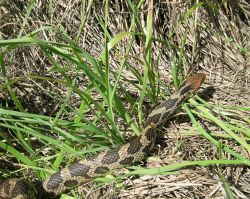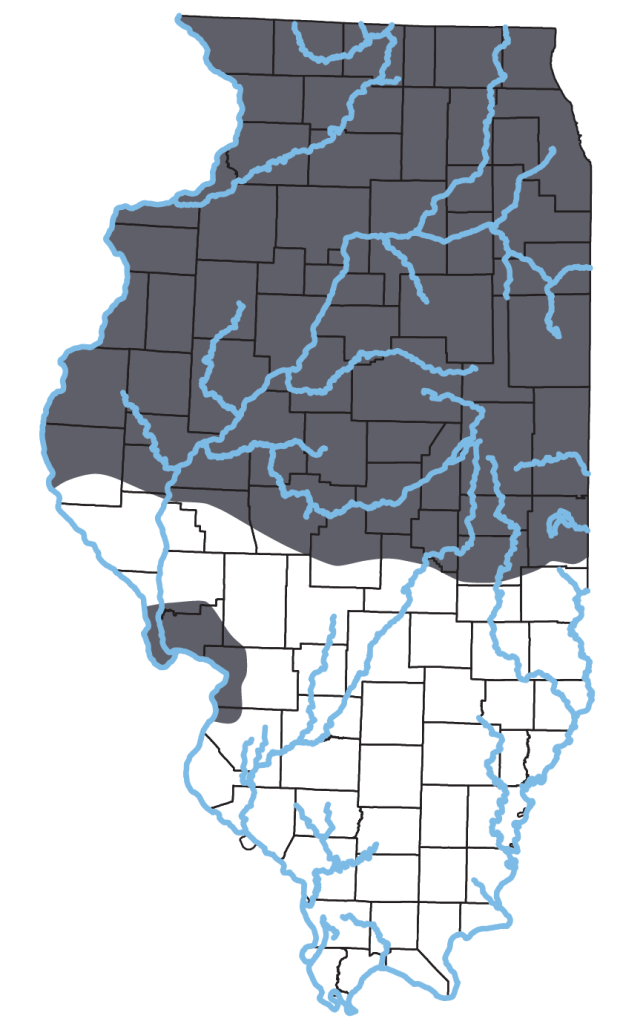Pantherophis vulpinus (Baird & Girard, 1853)


Key Characters: Back yellow with brown blotches; belly black with yellow checks; back scales weakly keeled; anal plate divided.
Similar Species: Yellow-Bellied Kingsnake, Milksnake, Gray Ratsnake, Great Plains Ratsnake, Bullsnake. What’s the difference between a fox snake and a massasauga? See the Key to Snakes of Illinois for help with identification.
Subspecies: None are currently recognized, but see Nomenclatural History below.
Description: Large (up to 130 cm TL) snake with copper-colored head distinctly wider than neck. Back yellow to bronze with 34-42 reddish brown blotches and an alternating row of brown spots along each side. Belly yellow and boldly marked with black. Hatchling and juvenile resemble adult except for having gray ground coloring and black or dark chestnut blotches.
Habitat: Variety of open and former prairie habitats, including intensively cultivated fields and pastures, in the northern half of the state.
Natural History: A diurnal constrictor that, like many other snakes, often vibrates its tail when threatened. Active early spring through late autumn, even on warm winter days when drawn from its underground hibernation. Mates from June to early July and lays 8-27 eggs about 30 days later. Young (ca. 23-30 cm TL) hatch in late August or September. Diet includes small mammals, birds, their eggs, and nestlings. Main predators are carnivorous mammals and raptors.
Status: Locally common, especially in Grand Prairie.
Etymology: Pantherophis – ?; vulpinus – (Latin) meaning ‘of foxes’
Original Description: Baird S.F. & C. Girard. 1853. Catalogue of North American reptiles in the Museum of the Smithsonian Institution. Part I. Serpents. Smithsonian Misc, Coll. 2(5):172 pp.
Type Specimen: Holotype, USNM (lost)
Type Locality: “Racine, Wisconsin”
Original Name: Scotophis vulpinus Baird & Girard, 1853
Nomenclatural History/ Recent Changes: Until recently, two subspecies were recognized, Eastern Foxsnake E. vulpina gloydi Conant, 1940 and Western Foxsnake, E. v. vulpina. Utiger et al. (2002. Molecular systematics and phylogeny of Old World and New World ratsnakes, Elaphe Auct., and related genera (Reptilia, Squamata, Colubridae). Russian Journal of Herpetology. 9 (2): 105-124) used molecular data to show that the genus Elaphe as recognized is paraphyletic and assigned the New World members of the genus to Pantherophis Fitzinger, 1843. Collins (1991, Herpetol. Rev. 22: 42–43) elevated gloydi to specific status based on geographic disjunction from vulpinus and the morphological characters noted by Conant (1940, Herpetologica 2: 2). Using molecular data, Crother et al. (2011, ISRN Zoology, doi:10.5402/2011/436049) supported species level differentiation, but with the geographic break being the Mississippi River and not the disjunction described by Conant which was farther east. The type locality of P. vulpinus is east of the Mississippi River and thus the appropriate available name for the eastern form. Davis & Rice (1883) used the name Coluber vulpinus in their Illinois list.


